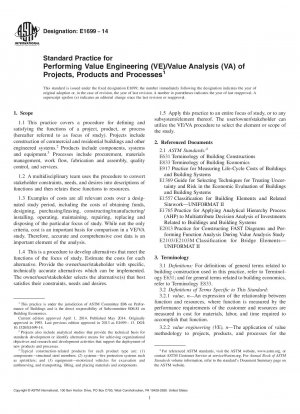ASTM E1699-14
Standard Practice for Performing Value Engineering 40;VE41;/Value Analysis 40;VA41; of Projects, Products and Processes
- Standard No.
- ASTM E1699-14
- Release Date
- 2014
- Published By
- American Society for Testing and Materials (ASTM)
- Status
- Replace By
- ASTM E1699-14(2020)
- Latest
- ASTM E1699-14(2020)
- Scope
5.1 Use of this practice may increase performance in one or more areas including: cost control; resource allocation; schedule management; quality control; risk management; or safety. Perform VE/VA as early as possible in the life cycle of the focus of study, and anytime conditions change, to allow greatest flexibility and effectiveness of any recommended changes. However, VE/VA may be performed at any time during the planning, design, and implementation phases of a project, product, or process.
5.2 Most effective applications of VE/VA are early in the design phase. Changes or redirection in the design can be accommodated without extensive redesign at this point, thereby saving the owner/user/stakeholder's time and money.
5.3 Projects Related to the Construction of Buildings and Other Engineered Systems:
5.3.1 During the earliest stages of design, refer to VE/VA as value planning. Use the procedure to analyze predesign documents, for example, program documents and space planning documents. At the predesign stage, perform VE/VA to define the project's functions, and to achieve consensus on the project's direction and approach by the project team, for example, the owner, the design professional,5 the user, and the construction manager. By participating in this early VE/VA exercise, members of the project team communicate their needs to the other team members and identify those needs in the common language of functions. By expressing the project in these terms early in the design process, the project team minimizes miscommunication and redesign, which are costly in both labor expenditures and schedule delays.
5.3.2 Also perform VE/VA during schematic design (up to 158201;% design completion), design development (up to 458201;% design completion), and construction documents (up to 1008201;% design completion). Conduct VE/VA studies at several stages of design completion to define or confirm project functions, to verify technical and management approaches, to analyze selection of equipment and materials, and to assess the project's economics and technical feasibility. Perform VE/VA studies concurrently with the user/owner's design review schedules to maintain the project schedule. Through the schematic design and design development stages, the VE/VA team analyzes the drawings and specifications from each technical discipline. During the construction documents stage, the VE/VA team analyzes the design drawings and specifications, as well as the details, and equipment selection, which are more clearly defined at this later stage.
5.3.3 A VE/VA study performed at a 90 to 1008201;% design completion stage, just prior to bidding, concentrates on economics and technical feasibility. Consider methods of construction, phasing of construction, and procurement. The goals at this stage of design are to minimize construction costs and the potential for claims; analyze management and administration; satisfy stakeholder needs; and review the design, equipment, and materials used.
5.3.4 During construction, analyze value analysis change proposals (VACP)/value engineering change proposals (VECP) of the contractor.6 VACPs/VECPs reduce the cost or duration of construction or present alternative methods of construction, without reducing performance or acceptance. To encourage the contractor to propose worthwhile VACPs/VECPs, the owner and the contractor share......
ASTM E1699-14 Referenced Document
- ASTM E1369 Standard Guide for Selecting Techniques for Treating Uncertainty and Risk in the Economic Evaluation of Buildings and Building Systems
- ASTM E1557 Standard Classification for Building Elements and Related Sitework-UNIFORMAT II
- ASTM E1765 Standard Practice for Applying Analytical Hierarchy Process (AHP) to Multiattribute Decision Analysis of Investments Related to Buildings and Building Systems
- ASTM E2013 Standard Practice for Constructing FAST Diagrams and Performing Function Analysis During Value Analysis Study
- ASTM E2103/E2103M Standard Classification for Bridge Elements—UNIFORMAT II
- ASTM E631 Standard Terminology of Building Constructions
- ASTM E833 Standard Terminology of Building Economics*, 2024-04-20 Update
- ASTM E917 Standard Practice for Measuring Life-Cycle Costs of Buildings and Building Systems
ASTM E1699-14 history
- 2020 ASTM E1699-14(2020) Standard Practice for Performing Value Engineering (VE)/Value Analysis (VA) of Projects, Products and Processes
- 2014 ASTM E1699-14 Standard Practice for Performing Value Engineering 40;VE41;/Value Analysis 40;VA41; of Projects, Products and Processes
- 2013 ASTM E1699-13 Standard Practice for Performing Value Engineering (VE)/Value Analysis (VA) of Projects, Products and Processes
- 2010 ASTM E1699-10 Standard Practice for Performing Value Analysis (VA) of Buildings and Building Systems and Other Constructed Projects
- 2000 ASTM E1699-00(2005) Standard Practice for Performing Value Analysis (VA) of Buildings and Building Systems
- 2000 ASTM E1699-00 Standard Practice for Performing Value Analysis (VA) of Buildings and Building Systems

Copyright ©2024 All Rights Reserved